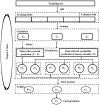Identifying First-Trimester Risk Factors for SGA-LGA Using Weighted Inheritance Voting Ensemble Learning
- PMID: 39061738
- PMCID: PMC11274223
- DOI: 10.3390/bioengineering11070657
Identifying First-Trimester Risk Factors for SGA-LGA Using Weighted Inheritance Voting Ensemble Learning
Abstract
The classification of fetuses as Small for Gestational Age (SGA) and Large for Gestational Age (LGA) is a critical aspect of neonatal health assessment. SGA and LGA, terms used to describe fetal weights that fall below or above the expected weights for Appropriate for Gestational Age (AGA) fetuses, indicate intrauterine growth restriction and excessive fetal growth, respectively. Early prediction and assessment of latent risk factors associated with these classifications can facilitate timely medical interventions, thereby optimizing the health outcomes for both the infant and the mother. This study aims to leverage first-trimester data to achieve these objectives. This study analyzed data from 7943 pregnant women, including 424 SGA, 928 LGA, and 6591 AGA cases, collected from 2015 to 2021 at the Third Affiliated Hospital of Sun Yat-sen University in Guangzhou, China. We propose a novel algorithm, named the Weighted Inheritance Voting Ensemble Learning Algorithm (WIVELA), to predict the classification of fetuses into SGA, LGA, and AGA categories based on biochemical parameters, maternal factors, and morbidity during pregnancy. Additionally, we proposed algorithms for relevance determination based on the classifier to ascertain the importance of features associated with SGA and LGA. The proposed classification solution demonstrated a notable average accuracy rate of 92.12% on 10-fold cross-validation over 100 loops, outperforming five state-of-the-art machine learning algorithms. Furthermore, we identified significant latent maternal risk factors directly associated with SGA and LGA conditions, such as weight change during the first trimester, prepregnancy weight, height, age, and obstetric factors like fetal growth restriction and birthing LGA baby. This study also underscored the importance of biomarker features at the end of the first trimester, including HDL, TG, OGTT-1h, OGTT-0h, OGTT-2h, TC, FPG, and LDL, which reflect the status of SGA or LGA fetuses. This study presents innovative solutions for classifying and identifying relevant attributes, offering valuable tools for medical teams in the clinical monitoring of fetuses predisposed to SGA and LGA conditions during the initial stage of pregnancy. These proposed solutions facilitate early intervention in nutritional care and prenatal healthcare, thereby contributing to enhanced strategies for managing the health and well-being of both the fetus and the expectant mother.
Keywords: AGA (appropriate for gestational age); LGA (large for gestational age); SGA (small for gestational age); first trimester ending; machine learning.
Conflict of interest statement
The authors declare no conflict of interest.
Figures









Similar articles
-
Measurement of Calprotectin and PTH in the Amniotic Fluid of Early Second Trimester Pregnancies and Their Impact on Fetuses with Growth Disorders: Are Their Levels Related to Oxidative Stress?J Clin Med. 2024 Feb 1;13(3):855. doi: 10.3390/jcm13030855. J Clin Med. 2024. PMID: 38337548 Free PMC article.
-
Fetal front-abdominal wall thickness in the second trimester as a predictor of abnormal fetal growth.J Matern Fetal Neonatal Med. 2022 Mar;35(6):1162-1168. doi: 10.1080/14767058.2020.1743666. Epub 2020 Mar 24. J Matern Fetal Neonatal Med. 2022. PMID: 32208785
-
Demographic, socio-economic, obstetric, and behavioral factors associated with small-and large-for-gestational-age from a prospective, population-based pregnancy cohort in rural Nepal: a secondary data analysis.BMC Pregnancy Childbirth. 2022 Aug 19;22(1):652. doi: 10.1186/s12884-022-04974-8. BMC Pregnancy Childbirth. 2022. PMID: 35986258 Free PMC article. Clinical Trial.
-
Third-trimester growth diversity in small fetuses classified as appropriate-for-gestational age or small-for-gestational age at birth.Ultrasound Obstet Gynecol. 2021 Dec;58(6):882-891. doi: 10.1002/uog.23688. Ultrasound Obstet Gynecol. 2021. PMID: 33998089
-
Intrapartum Fetal Electrocardiogram in Small- and Large-for-Gestational Age Fetuses.Am J Perinatol. 2021 Dec;38(14):1465-1471. doi: 10.1055/s-0041-1735285. Epub 2021 Aug 31. Am J Perinatol. 2021. PMID: 34464982 Free PMC article.
Cited by
-
Machine learning approaches for predicting fetal macrosomia at different stages of pregnancy: a retrospective study in China.BMC Pregnancy Childbirth. 2025 Feb 11;25(1):140. doi: 10.1186/s12884-025-07239-2. BMC Pregnancy Childbirth. 2025. PMID: 39934718 Free PMC article.
-
Impact of fetal sex on neonatal outcomes in women with gestational diabetes mellitus: a systematic review and meta-analysis.BMC Pregnancy Childbirth. 2025 Feb 3;25(1):110. doi: 10.1186/s12884-025-07250-7. BMC Pregnancy Childbirth. 2025. PMID: 39901155 Free PMC article.
References
-
- Black R.E., Victora C.G., Walker S.P., Bhutta Z.A., Christian P., De Onis M., Ezzati M., Grantham-McGregor S., Katz J., Martorell R., et al. Maternal and child undernutrition and overweight in low-income and middle-income countries. Lancet. 2013;382:427–451. doi: 10.1016/S0140-6736(13)60937-X. - DOI - PubMed
-
- Arias F., Bhide A.G., Arulkumaran S., Damania K., Daftary S.N. Practical Guide to High Risk Pregnancy and Delivery-E-Book: A South Asian Perspective. Elsevier Health Sciences; Amsterdam, The Netherlands: 2008.
-
- Morkuniene R., Cole T.J., Jakimaviciene E.M., Bankauskiene A., Isakova J., Drazdiene N., Basys V., Tutkuviene J. Regional references vs. international standards for assessing weight and length by gestational age in Lithuanian neonates. Front. Pediatr. 2023;11:1173685. doi: 10.3389/fped.2023.1173685. - DOI - PMC - PubMed
Grants and funding
LinkOut - more resources
Full Text Sources
Miscellaneous

